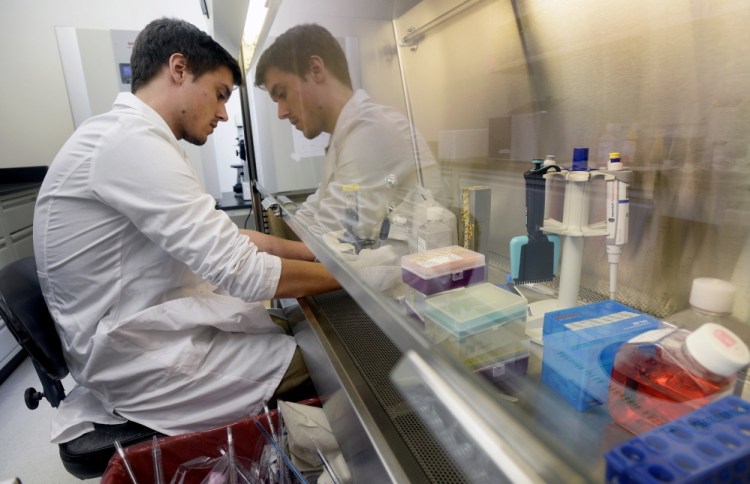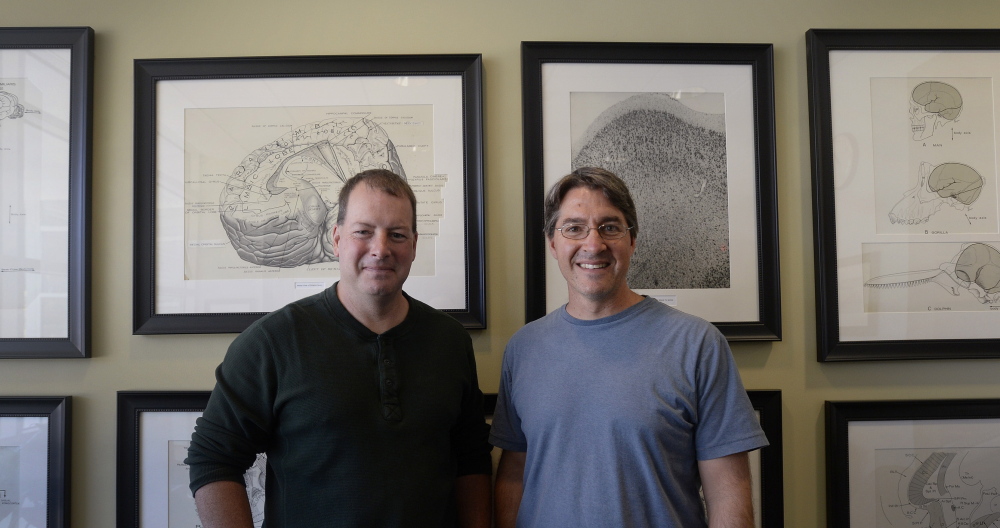At the University of New England in Biddeford, an assistant medical school professor and scientists-in-training are working to develop new kinds of painkillers without adverse side effects, while others are studying the genes of fruit flies to figure out how acute pain becomes chronic.
At Mercy Hospital’s pain center in Portland, chronic pain patients can attend a 12-week group program that focuses on helping them improve their function and quality of life, rather than focusing solely on reducing their pain.
The two southern Maine institutions are part of a national network of research and treatment centers trying to solve the mysteries of chronic pain and find new ways to help the millions of Americans who suffer from it.
The future of chronic pain treatment may be in manipulating the nervous system to block the transmission of pain. However, relatively little funding – compared to the prevalence of the condition – means it could be a while before new types of treatment are available.
For each of the 100 million Americans with chronic pain, the National Institutes of Health spends about $4 on research of the condition, according to a report released last week by the American Pain Society, a professional membership organization. At the same time, the agency’s per-patient spending is $41 for diabetes, $431 for cancer and $2,562 for HIV and AIDS, the report said.
Despite the relatively limited funding, there is a wide variety of research being done nationwide.
At Stanford University’s School of Medicine, a recent study looked at whether practicing compassion meditation, in which patients focus on wishing others well, could reduce pain. And at St. Louis University in Missouri, a professor of pharmacology published research last month that showed how activating a certain receptor in the brain and spinal cord of rodents can prevent or reverse pain from nerve damage.
The nervous system study is seen as breakthrough research, but humans are not likely to benefit immediately.
“We’re getting there, but it’s going to take awhile,” said Bob Twillman, incoming executive director of the American Academy of Pain Management.
The pain centers in Biddeford and Portland have benefited from their proximity to each other.
UNE medical students shadow doctors at Mercy Pain Center, and professors keep the pain doctors informed of the latest research in their field, said Edward Bilsky, co-director of UNE’s Center of Biomedical Research Excellence for the Study of Pain and Sensory Function.
UNE’s pain research center was established in 2012 with a $10 million grant awarded by the National Institutes of Health. The money is meant to build up the number of neuroscience investigators at the university by supporting start-up research projects that eventually can be funded through their own grants.
Also, as a result of the center, UNE’s College of Ostheopathic Medicine has a much more extensive pain curriculum than most medical schools, where the average of 12 hours spent on the topic has been identified in medical journals as insufficient.
Bilsky said UNE medical students get more than 50 hours of pain-related instruction – curriculum that extends into other departments at the university, including physical therapy, pharmacy and social work. Students from different fields of study come together for special projects and are given complex pain cases to work on as a team. They not only learn their respective roles, but also start to see pain problems through the eyes of other health care professionals they may need to consult with in the future, Bilsky said.
Such consulting happens on a daily basis at the Mercy Pain Center, which employs two anesthesiologists, two physiatrists, a family practice doctor and a pain psychologist all working together to assess, diagnose and treat patients who haven’t responded to previous treatments.
The Mercy Pain Center opened about three years ago in the hospital’s former maternity ward, offering a multi-disciplinary approach to pain management, including its Living Life Well Pain Rehabilitation Program.
In the program, groups of three to six patients meet twice a week to learn more about their condition and receive physical therapy, cognitive behavioral therapy and medical management with the goal of reducing their dependence on prescription painkillers. Graduates, on average, experience a 40 percent improvement in function, as well as a 20 percent reduction in pain.
More than 100 patients have been through the program so far, and one out of three of them improves their function by more than 50 percent, said medical director Dr. Stephen Hull.
That’s just one of the services provided by Mercy Pain Center, which receives about 300 new referrals a month, Hull said.
The center offers interventional pain management in the form of spinal cord stimulators, which are small devices implanted under the skin that send electric currents to interfere with pain impulses, and injections that can both treat and help diagnose pain. Hull said about half of the patients come to the center without a diagnosis for what is causing their pain.
With electrodiagnostic testing, the center can also look at the function of patients’ nerves to determine whether there’s been any damage.
Every other Thursday, the doctors at the pain center meet to discuss a new medical journal article or present a particularly difficult case. Faculty and students from UNE often attend because it helps inform their research, Bilsky said.
In turn, he said, that research may lead to discoveries that will end up helping the pain center patients.
Copy the Story Link
Send questions/comments to the editors.






Success. Please wait for the page to reload. If the page does not reload within 5 seconds, please refresh the page.
Enter your email and password to access comments.
Hi, to comment on stories you must . This profile is in addition to your subscription and website login.
Already have a commenting profile? .
Invalid username/password.
Please check your email to confirm and complete your registration.
Only subscribers are eligible to post comments. Please subscribe or login first for digital access. Here’s why.
Use the form below to reset your password. When you've submitted your account email, we will send an email with a reset code.